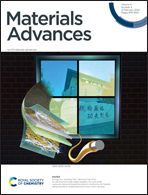An electrochemically stable Ag@Au–Co core–shell nanowire network-based transparent conductor for flexible self-powered Zn-based electrochromic smart devices†
Abstract
Silver nanowires (AgNWs) are important materials used to fabricate flexible transparent conductors (FTCs) for next-generation wearable electronics. However, the electrochemical instability still limits their practical application in electrochemical devices. Herein, highly stable FTCs are demonstrated via coating an Au–Co alloy shell around an AgNW core by electrodeposition. The AgNW@Au–Co core–shell network exhibited excellent resistance against chemical (in H2O2 solution for 200 s) and electrochemical corrosion (electrochemical anodic corrosion in 1 M H2SO4 solution for 100 s). Meanwhile, the modified FTC also possessed good optoelectrical performance and high mechanical stability (2000 bending cycles) owing to the firm metallic bonding between the stacked NWs during the electrodeposition process. To evaluate the improvement in electrochemical stability, a prototype of a self-powered polyaniline electrochromic smart system based on the versatile AgNW@Au–Co network FTC was fabricated, and it exhibited a high optical modulation range (41.22%) and good energy-storage performance (4 mF cm−2). Our strategy of introducing a protective alloy shell onto AgNW by electrodeposition opens a new door for realizing high-performance FTCs by a facile method to broaden their application in flexible electrochemical devices.



 Please wait while we load your content...
Please wait while we load your content...